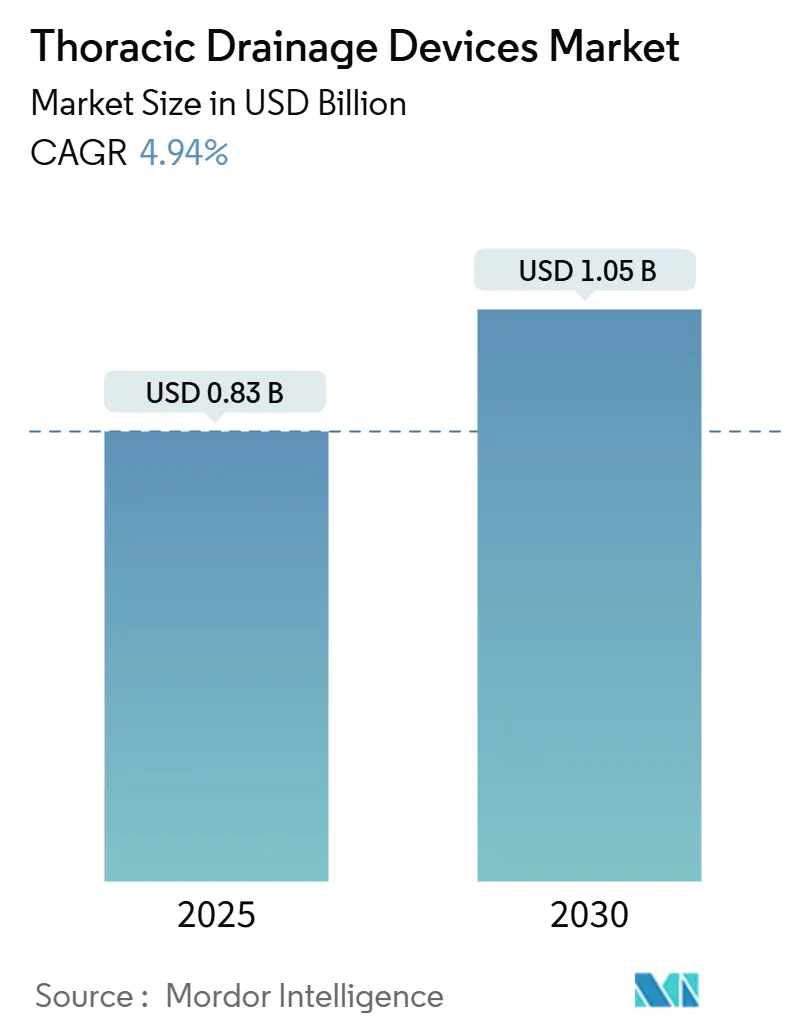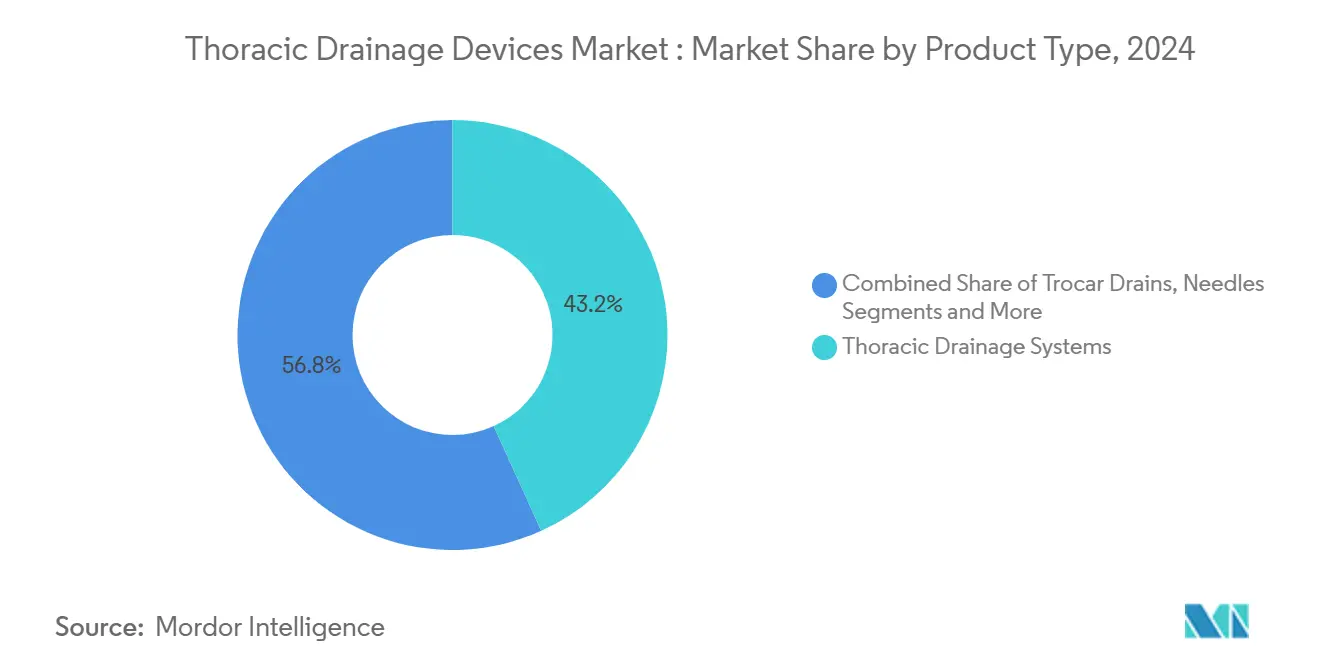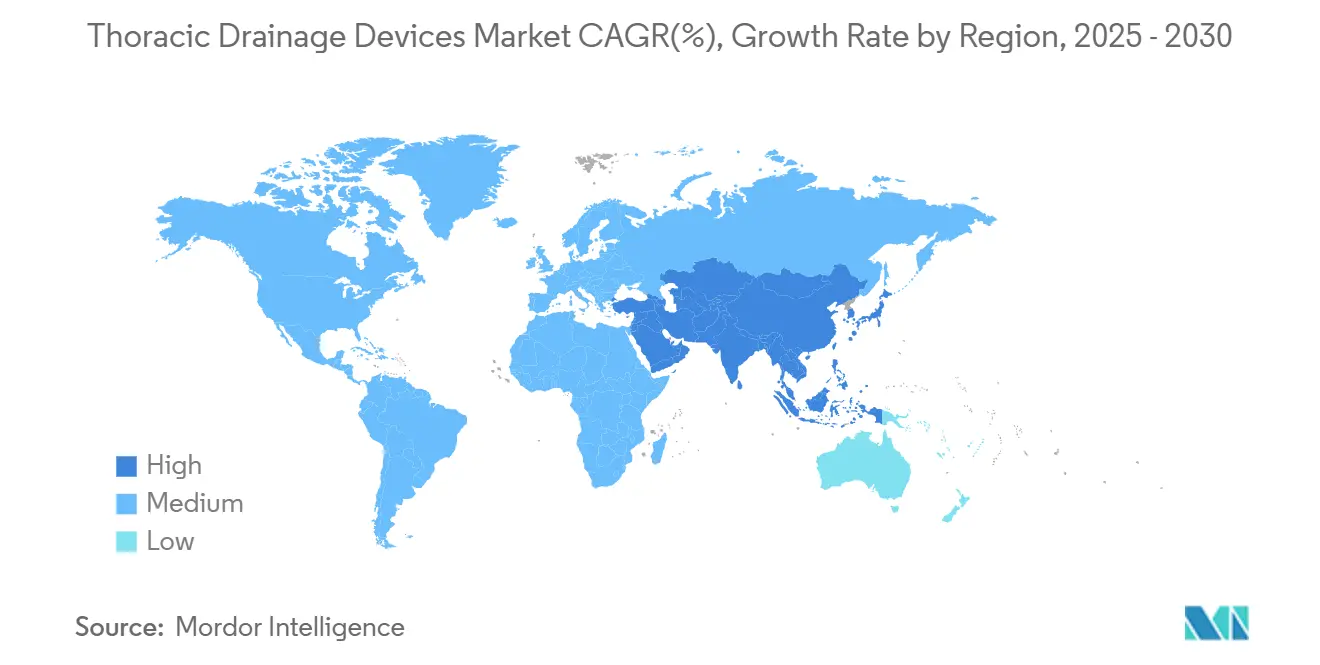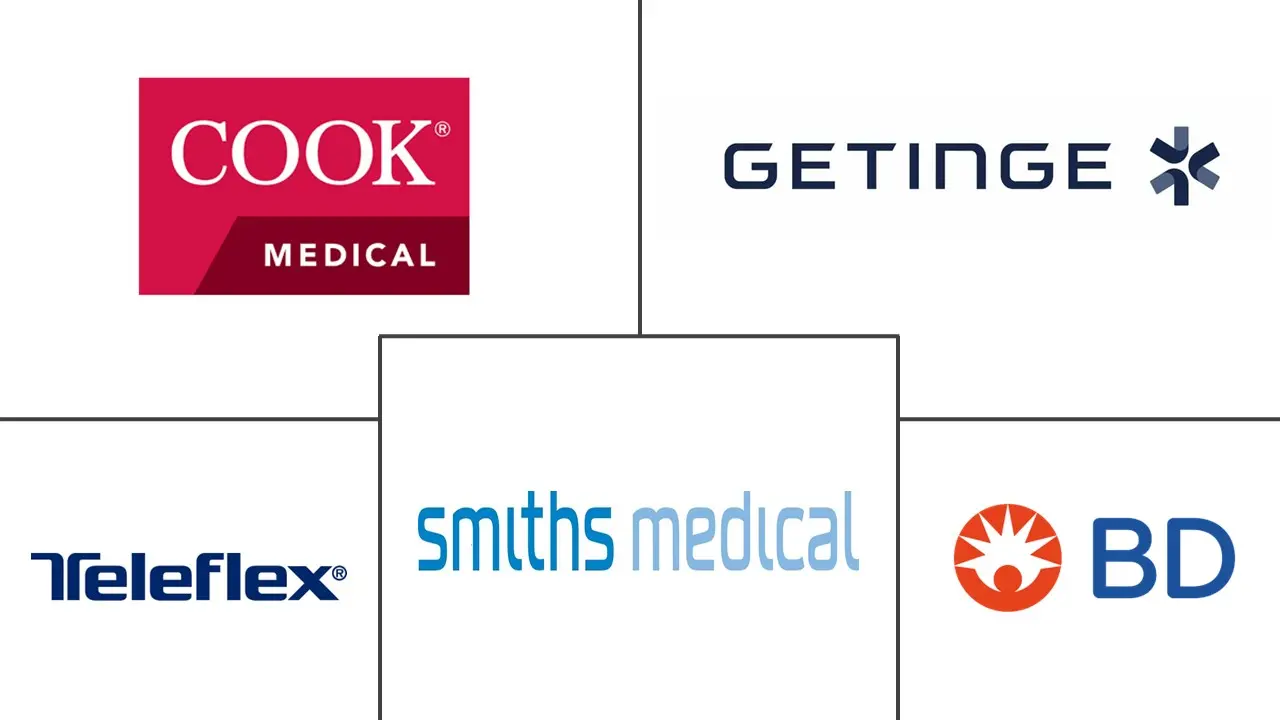Thoracic Drainage Devices Market Size and Share

Thoracic Drainage Devices Market Analysis by Mordor Intelligence
The thoracic drainage devices market size stands at USD 0.83 billion in 2025 and is forecast to reach USD 1.05 billion by 2030, reflecting a 4.94% CAGR over the period. The steady expansion rests on rising cardiovascular and thoracic surgical volumes, migration from analog water-seal devices to digital platforms, and widening adoption of portable units that shorten hospital stays.[1]Rajesh Kumar, “Clinical outcomes and staff satisfaction after adoption of digital chest drainage system for minimally invasive lung resections,” National Library of Medicine, pmc.ncbi.nlm.nih.gov Digital technology now links chest drainage to real-time analytics, allowing clinicians to spot air leaks or fluid shifts earlier and intervene sooner.[2]Shaoqing Huang, “Patent conversion of a novel closed chest drainage device,” BioMed Central, cardiothoracicsurgery.biomedcentral.com North America holds sway because of its sophisticated surgical infrastructure, yet Asia-Pacific is adding procedures faster as aging populations in China, India, and Japan swell demand for cardiac and pulmonary care. Hospitals remain the single largest end user, though ambulatory surgery centers and home-care programs are expanding quickly as payers favor outpatient models that control cost and improve patient mobility. Supply-chain resilience around specialty polymers has become a decisive differentiator because shortages of silicone and polyurethane can delay deliveries and raise prices.
Key Report Takeaways
- By product type, thoracic drainage systems led with 43.23% of thoracic drainage devices market share in 2024.
- By technology, analog water-seal units retained 58.56% share of the thoracic drainage devices market size in 2024, while digital electronic systems are projected to advance at an 8.88% CAGR to 2030.
- By application, cardiac surgery commanded 28.35% revenue share in 2024; ECMO is forecast to expand at an 8.47% CAGR to 2030.
- By end user, hospitals held 68.36% of thoracic drainage devices market share in 2024, whereas ambulatory surgery centers post the highest projected CAGR at 7.85% through 2030.
- By geography, North America dominated with 39.45% share in 2024; Asia-Pacific represents the fastest-growing region at 7.67% CAGR to 2030.
Global Thoracic Drainage Devices Market Trends and Insights
Drivers Impact Analysis
| Driver | (~) % Impact on CAGR Forecast | Geographic Relevance | Impact Timeline |
|---|---|---|---|
| Increasing Volume Of Thoracic & Cardiovascular Surgeries | +1.2% | Global, with concentration in North America & Europe | Medium term (2-4 years) |
| Rising Incidence Of Pneumothorax & Pleural Effusion | +0.8% | Global, with higher impact in Asia-Pacific | Long term (≥ 4 years) |
| Technological Advancements In Digital Drainage Systems | +1.1% | North America & EU leading, expanding to APAC | Short term (≤ 2 years) |
| Growing Geriatric Population With Cardiopulmonary Diseases | +0.9% | Global, with acute impact in developed markets | Long term (≥ 4 years) |
| Surge In ECMO Adoption Requiring Closed-Loop Drainage | +0.7% | Advanced healthcare systems globally | Medium term (2-4 years) |
| Miniaturised Portable Devices Enabling Outpatient Care | +0.6% | North America & Europe, expanding globally | Medium term (2-4 years) |
| Source: Mordor Intelligence | |||
Increasing Volume Of Thoracic & Cardiovascular Surgeries
Global cardiac and thoracic procedure counts keep rising as surgeons embrace minimally invasive techniques that lower operative risk and widen patient eligibility. Shorter incisions and faster recovery drive demand for drainage units that offer precise suction control and real-time leak detection. Meta-analysis shows digital devices trimming chest-tube duration by 0.72 days and hospital stay by 0.97 days, savings that offset higher acquisition cost. Hospitals value systems that automatically document drainage data into electronic records, easing staff workload and aiding reimbursement. As beating-heart and video-assisted surgeries proliferate, clinicians need devices that promptly flag subtle physiologic changes.
Rising Incidence Of Pneumothorax & Pleural Effusion
Environmental pollution, especially elevated PM2.5 levels, has correlated with more spontaneous pneumothorax cases in rapidly industrialising cities.[3]Xiaowen Hu, “Prevalence and recurrence rates of spontaneous pneumothorax in patients with diffuse cystic lung diseases in China,” BioMed Central, ojrd.biomedcentral.com A Chinese cohort reported a 31% prevalence among patients with diffuse cystic lung disease, underscoring the region’s sizable clinical burden. Surgical intervention reduces recurrence to 11%, driving demand for durable drainage kits capable of extended placement. Product designers now favour smaller-bore catheters that maintain flow yet lessen discomfort, supporting faster ambulation and earlier discharge. Manufacturers also incorporate antimicrobial linings to curb infection risk during multi-week dwell times.
Technological Advancements In Digital Drainage Systems
Digital platforms shift drainage from passive collection to active management by quantifying airflow and fluid volume on a second-by-second basis. Predictive algorithms alert staff to impending complications, which can prevent re-intervention and cut cost. Surgeons and nurses report greater workflow efficiency and higher satisfaction after switching from analog units. Bluetooth or Wi-Fi connectivity feeds dashboards that aggregate data for quality reviews, aiding value-based purchasing negotiations. As artificial intelligence matures, vendors embed analytical modules that recommend tube removal timing, further shortening length of stay.
Growing Geriatric Population With Cardiopulmonary Diseases
Populations over 65 continue to climb in North America, Europe, and parts of Asia, swelling caseloads of heart-valve repair, CABG, and lung resection. Dementia patients undergoing cardiac surgery experience more complications (65% vs 59%), prompting surgeons to seek drainage systems with intuitive alarms and simplified controls. Older adults often have reduced mobility, so portable suction units with lightweight canisters help clinicians mobilize patients earlier. Emerging personalized medicine protocols encourage tailoring suction pressure and duration to each patient’s physiology, a capability most readily delivered by software-driven devices.
Restraints Impact Analysis
| Restraint | (~) % Impact on CAGR Forecast | Geographic Relevance | Impact Timeline |
|---|---|---|---|
| High Cost Of Advanced Thoracic Drainage Systems | -0.9% | Global, with acute impact in price-sensitive markets | Short term (≤ 2 years) |
| Stringent & Variable Regulatory Approvals | -0.6% | Global, with regional variations in complexity | Medium term (2-4 years) |
| Supply-Chain Fragility For Specialty Polymers | -0.5% | Global manufacturing networks | Short term (≤ 2 years) |
| Preference For Minimally-Invasive Aspiration Alternatives | -0.4% | Advanced healthcare markets primarily | Medium term (2-4 years) |
| Source: Mordor Intelligence | |||
High Cost Of Advanced Thoracic Drainage Systems
Digital units can cost multiples of analog sets, stretching capital budgets in emerging economies. Beyond purchase price, buyers must fund disposables, training, and software updates. Hospitals in middle-income nations frequently delay upgrades until cost-effectiveness is proven through local data. Payers now negotiate value-based contracts where suppliers refund part of the price if agreed outcomes are not met. These financial pressures slow initial uptake of premium systems despite their clinical merits.
Stringent & Variable Regulatory Approvals
Bringing a new drainage platform to market entails distinct pathways in the United States, Europe, China, and Japan. The FDA’s pre-market submissions demand robust human data and post-market surveillance plans, often lengthening launch timelines.[4]Food and Drug Administration, “Determination of Regulatory Review Period for Purposes of Patent Extension; Gore Tag Thoracic Branch Endoprosthesis,” federalregister.gov Smaller innovators may lack resources for parallel filings, spurring partnership or licensing arrangements with larger firms. Fragmented rules also raise documentation costs, discouraging frequent iteration and feature updates.
Segment Analysis
By Product Type: Systems Drive Innovation Leadership
Thoracic drainage systems captured 43.23% of overall 2024 revenue, underscoring their central clinical role. Analog models still dominate cost-sensitive hospitals, yet digital variants post a 7.12% CAGR as facilities pursue better monitoring and shorter stays. Integrated pumps and electronic valves help standardise suction levels, which lowers complication rates. Thoracic drainage kits complement system sales by bundling tubing, dressings, and disposables, ensuring procedural consistency.
Material advances move the needle on patient comfort and infection control. Silicone and polyurethane catheters lessen tissue irritation, while silver or antibiotic coatings curb bacterial colonisation. Closed-incision negative-pressure devices bridge drainage with wound-care needs, creating cross-selling opportunities. Vendors that offer a full procedure package, from trocar to post-op monitoring, build loyalty and lock-in among high-volume surgical centers.

Note: Segment shares of all individual segments available upon report purchase
By Application: ECMO Procedures Accelerate Growth
Cardiac surgery generated 28.35% of 2024 sales thanks to established bypass and valve repair protocols that require dependable drainage. The thoracic drainage devices market size for ECMO, however, is projected to rise fastest at an 8.47% CAGR to 2030 as more centers adopt this life-support modality. ECMO patients need robust, leak-proof systems that manage high flow for extended durations. Digital units track pressure variations minute by minute, giving intensivists actionable insights.
Thoracic and pulmonology surgeries benefit from video-assisted lobectomies, which demand precise suction settings. Oncology cases increasingly rely on tunneled catheters for malignant effusions, creating demand for long-term, antimicrobial devices. Trauma and emergency departments prioritise quick-connect tubing and simple interfaces to speed lifesaving interventions. Each use case shapes design, reinforcing the need for broad product lines.
By End User: ASCs Drive Outpatient Transformation
Hospitals retained 68.36% of purchases in 2024, reinforcing their dominance in the thoracic drainage devices market. Large academic centers upgrade earlier to digital models because they can measure productivity gains. Outpatient surgery centers represent the growth frontier with a 7.85% CAGR, reflecting payer push toward lower-cost settings. To serve ASCs, manufacturers engineer lightweight systems with intuitive touchscreens and battery backup, allowing same-day discharge.
Pulmonology clinics and home-care services adopt portable units for chronic effusion management. Lightweight canisters and wireless alerts let patients ambulate freely, raising quality of life. Military field hospitals and disaster response teams also value rugged, easy-decontaminate equipment. Suppliers tailor kits by setting, bundling accessories such as carrying cases or wall mounts to match workflow.
By Technology: Digital Transformation Accelerates
Analog water-seal devices still hold 58.56% share, yet facilities switching to electronic systems cite clearer output data and fewer false alarms. Digital units advance at 8.88% CAGR and are expected to narrow the gap before 2030. Software now plots trends, predicts tube removal timing, and integrates with electronic records. Vacuum-assisted negative-pressure models refine control further, especially valuable in complex thoracic oncology cases.
Portable suction-assisted devices meet the growing outpatient demand. Models combine internal pumps, battery packs, and sealed canisters to maintain consistent suction during transport. Artificial-intelligence modules under development analyse leak curves to recommend interventions, strengthening clinical confidence in early discharge.

Note: Segment shares of all individual segments available upon report purchase
By Material: Polyurethane Innovation Drives Growth
Silicone accounted for 48.68% of 2024 demand, driven by softness, transparency, and inert chemistry. Clinical trials show silicone drains lower post-lobectomy pain scores while keeping drainage efficacy intact. Polyurethane follows with the fastest 7.32% CAGR because new blends offer antimicrobial additives and improved kink resistance. Polyvinyl chloride survives where price sensitivity overrules premium features.
Other engineered polymers such as PEEK fill specialty niches requiring extreme chemical stability or high temperature resistance. Supply-chain challenges around medical-grade silicone spur dual-sourcing strategies, making polyurethane an attractive alternative. Manufacturers now tout coatings that deter biofilm formation, targeting infection-control committees seeking to reduce catheter-associated complications.
Geography Analysis
North America led with 39.45% market share in 2024, buoyed by high surgical throughput, advanced reimbursement, and early digital uptake. United States hospitals invest aggressively in software-driven systems that reduce air-leak complications and length of stay. Canadian centers benefit from harmonised procurement guidelines that facilitate cross-provincial adoption, while Mexico’s private sector upgrades to digital units as medical tourism grows.
Asia-Pacific is projected to grow at a 7.67% CAGR, making it the fastest-advancing regional contributor to the thoracic drainage devices market. China’s hospital construction boom and reimbursement expansion add operating-room capacity, directly lifting demand for drainage kits. Japan’s super-aged society sustains valve and bypass volumes, anchoring steady demand for replacement cycles. India’s tier-one cardiac institutes adopt digital systems to differentiate on clinical outcomes, while Southeast Asian nations upgrade analog fleets as incomes climb.
Europe maintains a balanced profile of innovation and volume. Germany and the United Kingdom spearhead clinical trials that validate new digital algorithms under the EU Medical Device Regulation framework, bolstering physician confidence. France, Italy, and Spain add demand through public-sector refurbishments that replace aging analog units. Regional procurement groups press suppliers for evidence-based price concessions, encouraging bundling of disposables and service contracts.

Competitive Landscape
The thoracic drainage devices market remains moderately fragmented. Multinationals differentiate via broad portfolios that span analog, digital, and portable lines, giving clinicians one-stop sourcing. Digital capabilities now serve as prime battleground: firms with proprietary sensors and cloud dashboards secure multi-year volume agreements with high-acuity hospitals. Patent filings focus on closed-loop pressure regulation and AI-aided leak detection.
Supply-chain resilience is an emerging separator of winners and laggards. Leaders dual-source silicone and polyurethane, hold buffer inventory, and automate molding to lower cost variance. Smaller innovators partner with contract manufacturers to maintain flexible capacity and meet regional content rules. Mergers and licensing deals accelerate market entry in regions with stringent regulation, sharing clinical evidence dossiers to lower approval hurdles.
Service and training also underpin share defense. Vendors offer 24/7 remote monitoring support, predictive maintenance, and outcome-tracking reports that hospitals use for quality metrics. As reimbursement models shift toward bundled payments, hospitals lean on suppliers to document savings from earlier discharge and reduced complications, deepening strategic alignment.
Thoracic Drainage Devices Industry Leaders
-
Becton Dickinson and Company
-
Getinge AB
-
Smith Medical
-
Cook Medical
-
Teleflex Corporation
- *Disclaimer: Major Players sorted in no particular order

Recent Industry Developments
- April 2025: Coaxial silicone drains were shown to significantly reduce postoperative pain after VATS lobectomy without compromising efficacy, reinforcing silicone’s clinical edge.
- October 2024: The FDA disclosed the regulatory review period for the Gore Tag Thoracic Branch Endoprosthesis, underscoring the time and evidence needed to bring complex thoracic devices to market.
- June 2024: Pleural Dynamics treated the first patient with its fully implantable automatic effusion shunt in a clinical trial for pleural effusion management, highlighting innovation in long-term outpatient drainage.
Research Methodology Framework and Report Scope
Market Definitions and Key Coverage
Our study defines the thoracic drainage devices market as all single-use or reusable catheters, kits, trocar drains, and digital or analog chest drainage systems designed to clear air, blood, or fluid from the pleural or mediastinal space after trauma or surgery. Values represent factory-gate revenue from new units and their proprietary disposables, expressed in USD.
Scope Exclusions: simple wound drains, abdominal or neurosurgical drainage systems, and rental-only service contracts are not counted.
Segmentation Overview
- By Product Type
- Thoracic Drainage Systems
- Analog (Water-Seal) Systems
- Digital / Smart Systems
- Thoracic Drainage Kits
- Pleural Drainage Catheters
- Small-Bore (≤14 Fr)
- Large-Bore (>14 Fr)
- Trocar Drains
- Needles
- Secured Needle
- Unsecured Needle
- Closed Incision Negative Pressure Systems
- Thoracic Drainage Systems
- By Application
- Cardiac Surgery
- Thoracic Surgery & Pulmonology
- Trauma & Emergency Medicine
- Oncology & Pain Management
- Infectious Diseases & Sepsis
- ECMO Procedures
- By End User
- Hospitals
- Ambulatory Surgery Centers
- Specialized Pulmonology & Thoracic Clinics
- Military & Disaster Response Units
- Homecare Settings
- By Technology
- Analog Water-Seal
- Digital Electronic
- Portable Suction-Assisted
- Vacuum-Assisted Negative Pressure
- By Material
- Silicone
- Polyvinyl Chloride (PVC)
- Polyurethane
- Others (PEEK, TPE, etc.)
- By Geography
- North America
- United States
- Canada
- Mexico
- Europe
- Germany
- United Kingdom
- France
- Italy
- Spain
- Rest of Europe
- Asia-Pacific
- China
- Japan
- India
- Australia
- South Korea
- Rest of Asia-Pacific
- Middle East and Africa
- GCC
- South Africa
- Rest of Middle East and Africa
- South America
- Brazil
- Argentina
- Rest of South America
- North America
Detailed Research Methodology and Data Validation
Primary Research
Mordor analysts interviewed thoracic surgeons, trauma physicians, ICU nurses, and supply managers in the United States, Germany, India, and Brazil. Their feedback on digital-drain uptake, kit replacement cycles, and reimbursement nuances sharpened model inputs and confirmed price corridors.
Desk Research
We map procedure volumes and installed base using open datasets such as the WHO Global Health Observatory, OECD hospital-discharge files, Eurostat surgical registers, the US FDA MAUDE alerts, and leading thoracic journals. Company 10-Ks, procurement portals, and public price lists refine average selling prices, while D&B Hoovers and Dow Jones Factiva validate manufacturer revenue splits. This list is illustrative; many additional public records supported data collection and clarification.
Market-Sizing & Forecasting
A top-down rebuild of cardiac, thoracic, and trauma surgeries links procedure counts to device utilization ratios, then cross-checks bottom-up with sampled supplier shipments. Key variables modeled include pneumothorax incidence, average length of stay, digital system share, inflation-adjusted ASP, and hospital bed growth. Multivariate regression supported by scenario analysis projects demand through 2030; gaps in supplier data are bridged with channel checks and weighted averages.
Data Validation & Update Cycle
Outputs pass anomaly scans, senior analyst review, and management sign-off. We refresh annually and issue interim updates for recalls, guideline changes, or currency swings.
Why Our Thoracic Drainage Devices Baseline Commands Reliability
Published estimates vary because firms choose different product baskets, price decks, and refresh cadences. Mordor's clear scope, dual-path validation, and yearly update narrow those gaps.
Key gap drivers include some studies that fold wound drains, others that ignore digital systems, and several that rely on aging procedure datasets that miss ambulatory centers.
Benchmark comparison
| Market Size | Anonymized source | Primary gap driver |
|---|---|---|
| USD 0.83 B (2025) | Mordor Intelligence | |
| USD 0.89 B (2024) | Global Consultancy A | excludes smart systems; older ASP bench |
| USD 1.20 B (2024) | Trade Journal B | bundles vacuum wound drains; broad kit overlap |
Mordor's disciplined scope and frequent refresh therefore give clients a transparent, dependable baseline for planning.
Key Questions Answered in the Report
1. What is the current size of the thoracic drainage devices market?
The thoracic drainage devices market size is USD 0.83 billion in 2025.
2. How fast is the market expected to grow?
It is projected to rise at a 4.94% CAGR, reaching USD 1.05 billion by 2030.
3. Which application is growing the quickest?
ECMO procedures represent the fastest-growing application segment with an 8.47% CAGR through 2030.
4. Why are digital drainage systems gaining traction?
Digital platforms provide real-time monitoring, predictive analytics, and shorter hospital stays, which offset their higher capital cost.
5. Which region will deliver the highest future growth?
Asia-Pacific is forecast to expand at a 7.67% CAGR due to rising surgical volumes and healthcare investment.
6. What materials dominate chest drainage catheters today?
Silicone leads with 48.68% share because of biocompatibility and patient comfort, while polyurethane is the fastest-growing alternative.
Page last updated on:



